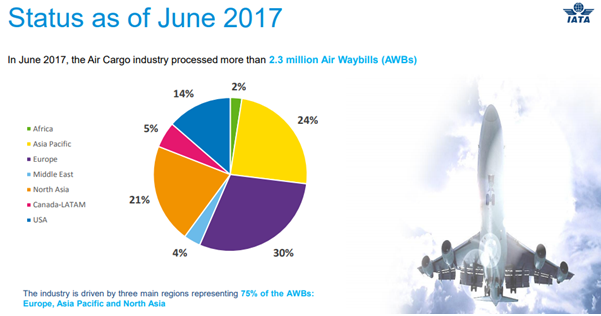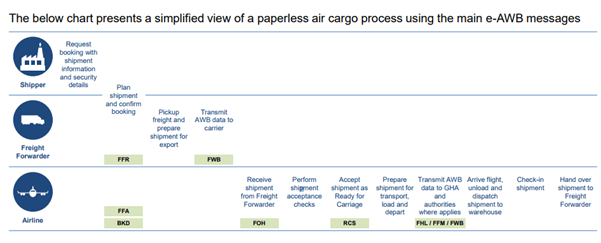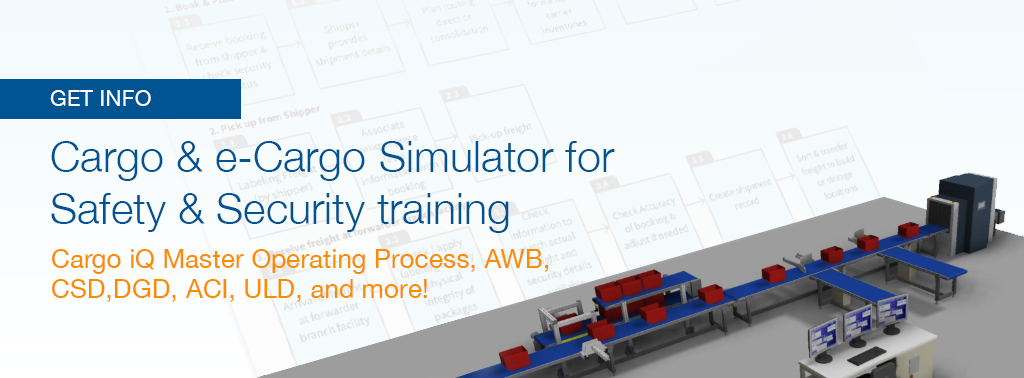The Airway Bill (AWB) is one of the central documents in international air cargo. Paper-based AWBs are causing tons of paper, are error prone, open a flank for crime and are inefficient and outdated as a process concept. This is why IATA is pushing the migration over to the fully electronic e-Cargo process.
What is the AWB?
The airway bill is the most important document issued by a carrier either directly or through its authorized agent. It is a non-negotiable transport document that covers transport of cargo from airport to airport. By accepting a shipment, an IATA cargo agent is acting on behalf of the carrier whose air waybill is issued.
The air waybill is a contract- an agreement enforceable by law. However, for it to be a valid contract, the AWB has to be signed by the shipper or his agent and by the carrier or its authorized agent. Although the same individual or organisation may act on behalf of both the carrier and the shipper, the air waybill must be signed twice one each in the respective carrier and shipper boxes. Both signatures may be of the same person. This also implies that the air waybill should be issued immediately upon receipt of the goods and letter in instructions from the shipper.
Note: As long as the airway bill is neither dated nor signed twice, the goods do not fall within the terms of the conditions of contract and therefore the carrier will not accept any responsibility for the goods. The validity of the air waybill and thus the contract of carriage expires upon delivery of the shipment to the consignee (or his authorized agent).
AWBs find their importance in making bookings, checking the status of delivery, and locating the position of the shipment, during its cycle.
Legitimate air waybills have eleven digit numbers.
Moving towards eAWB
The Electronic Air Waybill Resolution 672 (MeA) cancels the need for a paper AWB. There is therefore no longer a need to print, handle or archive the paper, largely simplifying the air cargo process. Thus there is no longer the need to print, handle or archive the paper AWB, simplifying the air cargo process (MOP) and moving towards a 100% e-Cargo vision.
The increasing importance of the eAWB can be gauged by this.
Consider the scenario in 2016:
- More than 50% of the global air trade relied on paper-based processes.
- A shipment could generate up to 30 paper documents and many of the processes, such as track and trace, still depended on human intervention.
- Each year, more than 7,800 tons of paper documents were processed, the equivalent of 80 Boeing 747 freighters filled with paper!
In contrast, consider the scenario in 2017:
The following diagram shows the IATA stipulated process that involves the shipper, the freight forwarder and the airline. And it is online, integrated, paper-free and safe.
The new process is expected to accelerate the process. Password protected users and authenticated transactions increase the level of security. In the future, digital signatures might be added to identify each user unmistakably and to provide non-repudiation and legal assurance.
New requirements like EU's ACC3 Programme require a safe supply chain. It is expected that the e-Cargo process will be sooner or later mandatory when importing goods into the European Union.
A Training Environment and Testbed for the e-Cargo Process
 SkyRadar implemented the complete e-Cargo process as end-to-end implementation including a connected cargo handling system.
SkyRadar implemented the complete e-Cargo process as end-to-end implementation including a connected cargo handling system.
The eCargo Training System provides an environment for technical and procedural training of aviation security and the CARGO supply chain as regulated by IATA and EU in the context of ACC3 (protected supply chain limited to certified forwarders, carriers and Ground Handling Agents). e-CARGO is the base module of a full e-CARGO laboratory.
The system provides an optimized environment to practice the IATA regulations and procedures for efficient and compliant air cargo management and security management.
It implements the IATA eCARGO-XML standard, following the Industry Master Operating Plan (MOP), mapping the relevant processes and security features from the initial shipper to the final consignee.
The core version of eCargo is software-based and pre-installed on a server.
It can be extended with a real Cargo SCADA and conveyor system as well as a X-ray scan simulator or an x-ray scanner.
Features
The conception of the system takes account and supports training in the context of the following regulations:
- IATA e-Cargo
- ACC3 Programme of the European Union
- Dangerous Goods Regulation (IATA Regulation 618 Attachment “A”)
- IATA ULD Regulation
- IATA CARGO-XML message protocols and standards
- IATA Aviation Cyber Security Toolkit
- EUROCONTROL Manual for National ATM Security Oversight
This training laboratory takes specific consideration of the ACC3 ('Air cargo and mail carrier operating into the Union from a Third Country Airport') programme.
References
- More articles on IATA's e-Cargo Process (2018 - today), by Dennis Vasilev, Dr. Ulrich Scholten and more
- More articles on ATSEP training in accordance with ICAO 10057 (2018 - today), by Dawn M. Turner, Dennis Vasilev, Prof. Eric Moskwa, Dr. Ulrich Scholten and more
- More articles on Radar Training Systems (2018 - today), by Dennis Vasilev, Dr. Ulrich Scholten and more
- Manual on Air Traffic Safety Electronics Personnel, Competency-Based Training and Assessment DOC 10057 (2017), by ICAO






